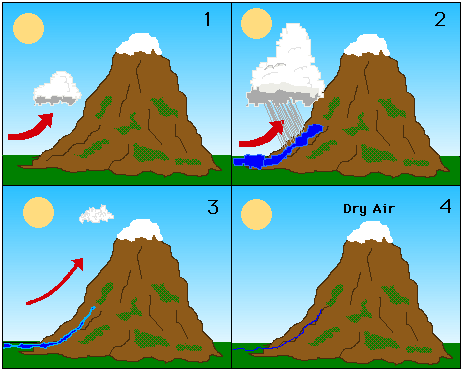| |
|
Equivalent Potential Temperature ( e) e)
Once rising air reaches the LCL or, condensation level, and clouds begin
to form, we can no longer refer to the lifting as a dry adiabatic process. When a parcel of
air becomes saturated and condensation begins, the process of condensation
releases latent heat into the surrounding air. This latent heat further
warms the air making the air even more buoyant. We refer to this as a
moist adiabatic process or saturated adiabatic process. Moist
adiabatic expansion increases the instability of the parcel. The moist
adiabatic lapse rate is not as steep as the dry adiabatic lapse rate
meaning a parcel of air that has risen above the LCL will not cool as
rapidly as it did before reaching the LCL. If this process of moist
adiabatic expansion continues, all of the water may condense out of the
rising parcel and precipitate out, yielding a dry parcel. The potential
temperature of that new dry parcel is called the equivalent potential temperature ( e) of the original
moist parcel. So, the equivalent potential temperature is the potential
temperature of a parcel of air after all of the water vapor has condensed
and fallen out of the parcel. e) of the original
moist parcel. So, the equivalent potential temperature is the potential
temperature of a parcel of air after all of the water vapor has condensed
and fallen out of the parcel.
Let's continue with our example of the air lifting up the side of the
mountain. If the mountain is high enough, and the parcel or layer of air
continues to lift, all of the moisture in the lifting air could condense
and fall out of the air in the form of precipitation. Once this occurs,
the potential temperature of the now dry air is considered the equivalent
potential temperature of the original moist parcel before condensation
began. Like the potential temperature and the LCL, the equivalent
potential temperature will also be a key player when we discuss vertical
stability. The equivalent potential temperature will help us determine
the stability of a thick layer of air versus the stability of a single
isolated parcel. Once again, this is one piece in the puzzle that will be
necessary later when we try to attach all of the pieces together.
(Note: in Block 4 in the graphic below, you should understand that the air continues to flow over the mountain, the graphic does not show continuing air flow).
 You can explore this concept in more depth with the equivalent potential temperature calculator.
You can explore this concept in more depth with the equivalent potential temperature calculator.
Confused? Have a question? If so, check out the Frequently Asked Questions (FAQ) page or send mail to the OS411 tutor (os411tutor@shodor.org) with your question!
Report technical/content problems here
|
|